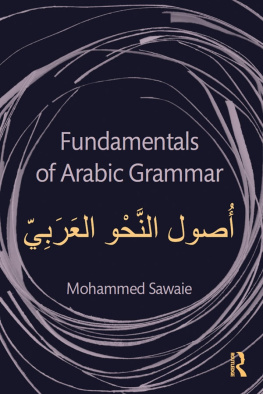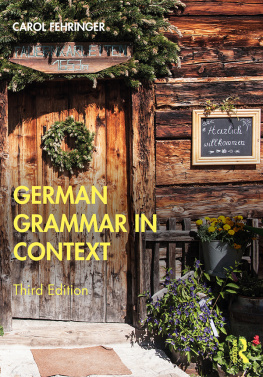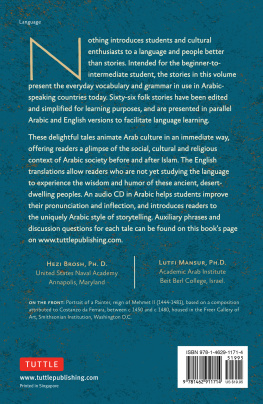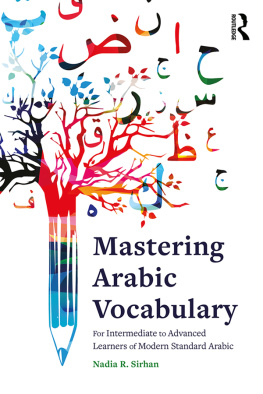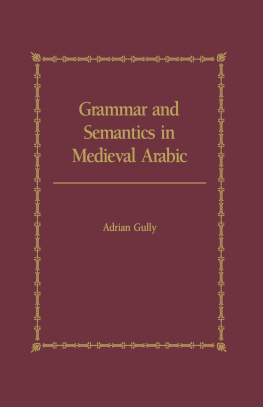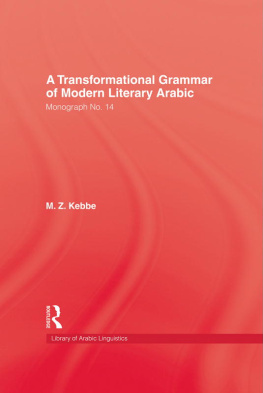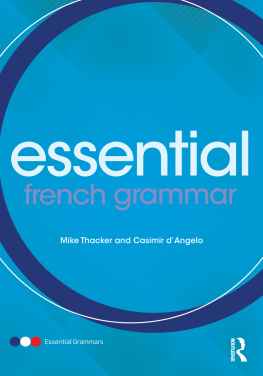This book is intended for intermediate and advanced learners of Arabic for understanding how Arabic functions within authentic texts as well as for developing comprehension and productive grammar skills.
A catalog record for this book has been requested ISBN: 978-0-415-71595-9 (hbk) ISBN: 978-0-415-71596-6 (pbk) ISBN: 978-1-315-65140-8 (ebk) Typeset in Minion and Frutiger by Bookbright Media
This book is intended for intermediate and advanced learners of Arabic for understanding how Arabic functions within authentic texts as well as for developing comprehension and productive grammar skills.
It can be used as a:
- main text for an Arabic grammar and structure course to develop or consolidate a robust knowledge of the grammar and structure in context
- supplementary text for Arabic language courses and programs during the first 2 to 5 years of Arabic
- main text in a bridging course intended to prepare students to tackle content-based courses taught exclusively in Arabic
- main text in a course of Arabic language through literature and culture due to the careful selection of its well over fifty authentic texts and the attention given to vocabulary, with a glossary of vocabulary and expressions provided at the end of the book
- self-study source, with the texts and exercises being fully vocalized and an answer key of all the exercises provided.
The book can best be used in combination with the Arabic grammar reference: Modern Standard Arabic Grammar: A Learners Guide (Alhawary 2011). Each chapter contains two authentic texts: one beginning the chapter and another concluding it. The first text is intended to highlight the grammar point in focus. The concluding text is intended to serve the learning objectives of a given chapter. It is provided unvocalized in order to serve additionally as a review text of the preceding chapters incrementally. All texts are graded (in terms of both structure and vocabulary) according to proficiency (from the intermediate to the advanced level and beyond), according to frequency (from the more frequent to the less frequent), and according to communicative functions (from the more basic to the more formal).
Since texts are graded, this means that exposure to the grammar points presented throughout the book is incremental; subsequent texts recycle previous grammar points so that any given text can also be used for additional practice and/or homework assignments of points presented in a previous text or texts. This feature will additionally aid in grammar learning and retention. The texts are by different authors (both male and female) from across the Arab world and from different genres (literary and non-literary). Apart from some texts selected from the Medieval period, the majority of texts are from roughly the past 100 years. To preserve the authenticity of the texts, no significant alterations of vocabulary and structures are made and almost all modifications, when necessary to control for length, are in the forms of omissions. A few structures (such as adverbs) explained in subsequent chapters are left deliberately for foreshadowing and to preserve the authenticity of the text.
Following the first text, each chapter contains three sections to explain the grammar points highlighted in the text: Form, Use, and Other points to note. The third section is intended to explain secondary points in the text or relevant points not in the text. Cross-references are made to relevant sections of other grammar points within the book. References to the relevant sections of the reference grammar book mentioned above are provided under the heading See for further information. These four sections are then followed by five exercises (including the concluding text), which aim at developing comprehension and production grammar skills. The exercises recycle both vocabulary and structure presented in previous chapters so that the book makes it possible to learn vocabulary while learning grammar robustly.
To aid the intermediate learner (in the first 15 chapters) and help avoid any confusion to do with verb conjugations or derivations of certain words (such as derived verbal nouns), texts and exercises are fully vocalized at the word level whether or not a light/eliding hamza (word initially preceded by a vowel) is present or where a helping vowel would be needed. Beyond of the reference grammar book. However, some learners may not have been exposed to such rules. Reading rules are essential in the ability to read at the sentence level; i.e., beyond the word level. In addition to grammar, attention is also paid to vocabularybeyond the selection of texts with level-appropriate vocabulary. To make the texts widely accessible and to aid in the learning and retention of vocabulary, a glossary of words, idiomatic expressions, and collocations is provided at the end of the book.
The words and expressions are arranged alphabetically for easy access, taking into account the intermediate learner in particular. When a verb in either of the two texts of a given chapter occurs, the verb is provided in the dictionary in its past and present form together with its verbal noun and preposition, if a particular one is used. A noun or adjective occurring in the singular is provided with its plural form and vice versa, unless such a word is rarely used. In the event a given word has two different meanings, the different meanings are separated by a semicolon; so are expressions from words. Words which have more frequently used synonyms are signaled by including the more frequently used words preceded by the = symbol in parentheses. Additionally, seven review texts are included in a final chapter.
These review texts provide the learner with an opportunity to review and integrate all the points learned in the preceding chapters. They are also added to further tap the rich variety of sources and genres of Arabic and for the learner to develop appreciation of such texts. Since such texts presuppose advanced levels of proficiency, meanings of only key vocabulary in the texts are provided. Each text has a different set of brief analytical questions to help the learner apply again what they have learned and to further develop appreciation of grammar and understanding how grammar contributes to meaning. The book is by no means an exhaustive coverage of all Standard Arabic grammar. However, it contains a significant amount of the grammar which students find difficult to learn.


